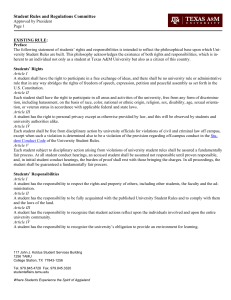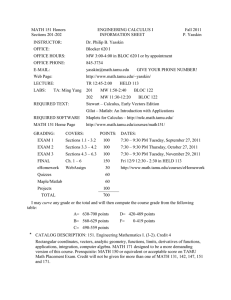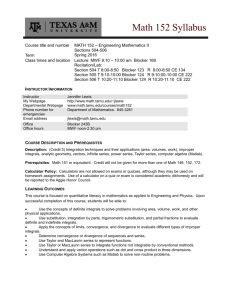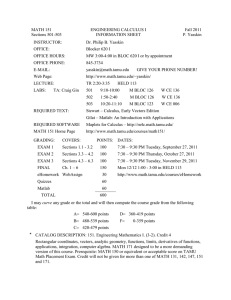Math 152 Syllabus
advertisement
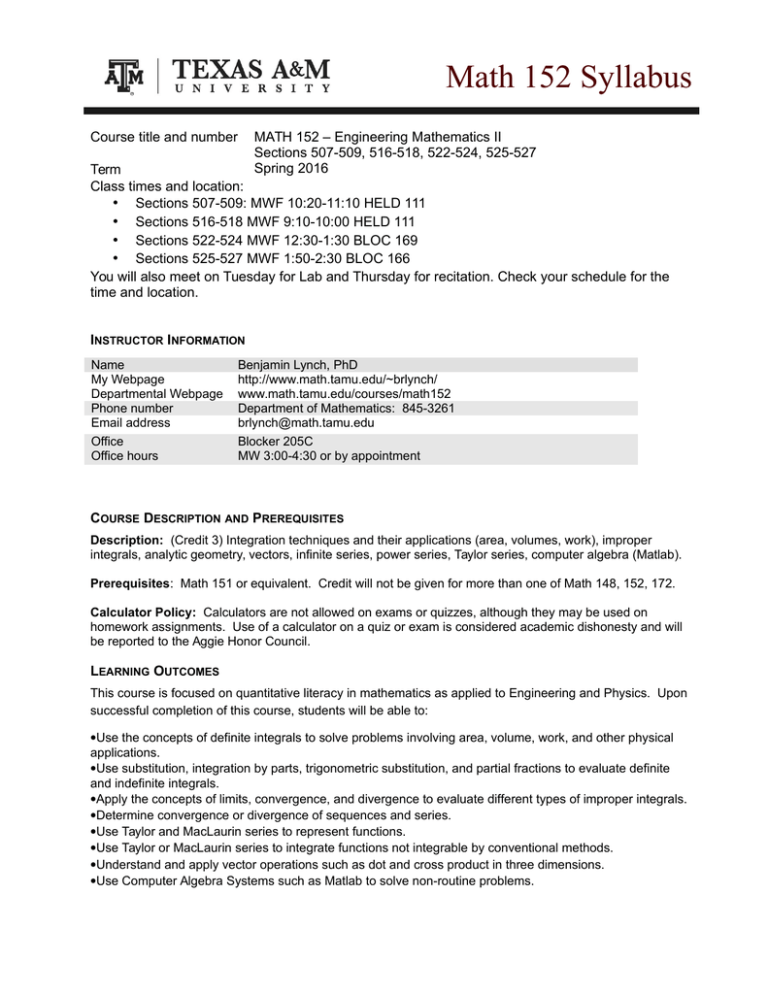
Math 152 Syllabus Course title and number MATH 152 – Engineering Mathematics II Sections 507-509, 516-518, 522-524, 525-527 Spring 2016 Term Class times and location: • Sections 507-509: MWF 10:20-11:10 HELD 111 • Sections 516-518 MWF 9:10-10:00 HELD 111 • Sections 522-524 MWF 12:30-1:30 BLOC 169 • Sections 525-527 MWF 1:50-2:30 BLOC 166 You will also meet on Tuesday for Lab and Thursday for recitation. Check your schedule for the time and location. INSTRUCTOR INFORMATION Name My Webpage Departmental Webpage Phone number Email address Office Office hours Benjamin Lynch, PhD http://www.math.tamu.edu/~brlynch/ www.math.tamu.edu/courses/math152 Department of Mathematics: 845-3261 brlynch@math.tamu.edu Blocker 205C MW 3:00-4:30 or by appointment COURSE DESCRIPTION AND PREREQUISITES Description: (Credit 3) Integration techniques and their applications (area, volumes, work), improper integrals, analytic geometry, vectors, infinite series, power series, Taylor series, computer algebra (Matlab). Prerequisites: Math 151 or equivalent. Credit will not be given for more than one of Math 148, 152, 172. Calculator Policy: Calculators are not allowed on exams or quizzes, although they may be used on homework assignments. Use of a calculator on a quiz or exam is considered academic dishonesty and will be reported to the Aggie Honor Council. LEARNING OUTCOMES This course is focused on quantitative literacy in mathematics as applied to Engineering and Physics. Upon successful completion of this course, students will be able to: Use the concepts of definite integrals to solve problems involving area, volume, work, and other physical applications. Use substitution, integration by parts, trigonometric substitution, and partial fractions to evaluate definite and indefinite integrals. Apply the concepts of limits, convergence, and divergence to evaluate different types of improper integrals. Determine convergence or divergence of sequences and series. Use Taylor and MacLaurin series to represent functions. Use Taylor or MacLaurin series to integrate functions not integrable by conventional methods. Understand and apply vector operations such as dot and cross product in three dimensions. Use Computer Algebra Systems such as Matlab to solve non-routine problems. TEXTBOOK AND/OR RESOURCE MATERIAL Textbook: Stewart, Calculus: Early Vectors, Cengage Learning. You paid for an electronic version of this textbook (eBook) through the online system WebAssign when you paid for your courses. Information on how to access your eBook can be found under the “Student Information Page” at http://www.math.tamu.edu/courses/eHomework. You are welcome to purchase a physical copy of the textbook or a loose-leaf copy of the text if you prefer, but this is not required. Lab Manual: Gilat-Amos, MATLAB: An Introduction with Applications, 5th edition, Wiley GRADING POLICIES The course grading will be based on the tables below. Grade Breakdown Activity Homework Quizzes Labs Common Exam I Common Exam II Common Exam III Average of 3 Exams Final Exam TOTAL Grading Scale Range 90 ≤ Average ≤ 100 80 ≤ Average < 90 70 ≤ Average < 80 60 ≤ Average < 70 Average < 60 Date Weekly Weekly See Lab Schedule Thursday, Feb 18, 7:30-9:30pm Thursday, Mar 24, 7:30-9:30pm Tuesday, Apr 26, 1, 7:30-9:30pm (see below) Percent 10% 10% 5% 50% 25% 100% Grade A B C D F Final Exam The final exam will be cumulative, covering all the material in the course. The final exam will take place on the following dates: • Sections 507-509: Monday, May 9, 8:00 am –10:00 am • Sections 516-518: Friday, May 6, 8:00 am – 10:00 am • Sections 522-524: Friday, May 6, 10:30 am – 12:30 pm • Sections 525-527: Monday, May 9, 3:30 pm – 5:30 pm Attendance and Makeup policies •Excused absences: Attendance is mandatory and may affect your grade. For excused absences we refer the student to Student Rule 7 at http://student-rules.tamu.edu/rule07. Excuses for absences must be substantiated by appropriate documentation. Falsification of documentation is a violation of the Honor Code. Notification before the absence is required when possible. Otherwise, you must notify me within 2 working days of the missed exam, quiz, or assignment to arrange a makeup. Further, an absence due to a non-acute medical service or appointment (such as a regular checkup) is not an excused absence. •Makeup exams will be only allowed due to excused absences and the next possible make-up time be chosen from http://www.math.tamu.edu/courses/makeupexams.html. If you foresee the need to be absent during an exam, you must notify the instructor in advance. ADDITIONAL COURSE INFORMATION AND POLICIES •Homework – Online homework assignments will be done in WebAssign. Access to WebAssign was included when you paid for your courses. Other important information such as how to log in, how to access and take assignments, and the Student Help Request Form can be found at http://www.math.tamu.edu/courses/eHomework. I suggest you bookmark this page and visit it before you log in to WebAssign each time. The lowest two WebAssign grades will be dropped. •Quizzes – Each week there will be a quiz in recitation. No calculators will be allowed. The lowest quiz grade will be dropped. •Matlab – Their will be assignments using matlab. Please contact your TA for any questions concerning matlab. COURSE TOPICS (Tentative weekly schedule) WEEK TOPIC Review of the Fundamental Theorem of Calculus, integration 1 2 3 4 5 6 7 8 9 10 11 12 13 14/15 by substitution, area Area, volumes by slicing, disks, washers Volume by cylindrical shells, work Average value, integration by parts, trigonometric integrals Trigonometric substitution, partial fractions. Exam 1 (Covers through Section 8.2). Improper integrals, arc length, surface area of revolution Sequences, Series Series, convergence tests Absolute convergence, convergence tests. Exam 2 (Covers through Section 10.2). Power series, representing functions as power series Taylor and Maclaurin series, applications of Taylor series 3D coordinates, vectors, dot product Cross product Polar coordinates. Exam 3 (Covers through Section 11.2), Review for Final Exam SECTIONS COVERED Sections 6.4–6.5, 7.1 Sections 7.1–7.2 Sections 7.3–7.4 Sections 7.5, 8.1–8.2 Sections 8.3–8.4 Sections 8.9, 9.3–9.4 Sections 10.1–10.2 Sections 10.2–10.3 Section 10.4 Sections 10.5–10.6 Sections 10.7, 10.9 Section 11.1–11.2 Section 11.3 Section 13.4 AMERICANS WITH DISABILITIES ACT (ADA) The Americans with Disabilities Act (ADA) is a federal anti-discrimination statute that provides comprehensive civil rights protection for persons with disabilities. Among other things, this legislation requires that all students with disabilities be guaranteed a learning environment that provides for reasonable accommodation of their disabilities. If you believe you have a disability requiring an accommodation, please contact Disability Services, currently located in the Disability Services building at the Student Services at White Creek complex on west campus or call 979-845-1637. For additional information, visit http://disability.tamu.edu. ACADEMIC INTEGRITY Aggie Honor Code: “An Aggie does not lie, cheat, or steal, or tolerate those who do.” Upon accepting admission to Texas A&M University, a student immediately assumes a commitment to uphold the Honor Code, to accept responsibility for learning, and to follow the philosophy and rules of the Honor System. Students will be required to state their commitment on examinations, research papers, and other academic work. Ignorance of the rules does not exclude any member of the TAMU community from the requirements or the processes of the Honor System. For additional information please visit: http://aggiehonor.tamu.edu Suggested Homework from Stewart Textbook This homework will not be graded, but is good preparation for the quizzes and exams. Section Problems 6.4 # 1, 3, 7, 9, 11, 19, 23, 27, 31, 41, 47, 51, 57, 73, 77, 79, 83, 93, 95 6.5 # 5, 7, 11, 19, 27, 28, 33, 35, 37, 39, 43, 46, 47, 55, 58, 61, 65, 81 7.1 # 1, 3, 7, 13, 17, 23, 25, 27, 31, 33, 35, 45*, 57 7.2 # 1, 3, 7, 9, 13, 17, 19, 20, 21, 22, 35, 45, 51, 56, 57, 58, 59, 61 7.3 # 1, 3, 5, 11, 17, 19, 25, 27, 29, 33, 34, 35, 37, 38, 41 7.4 # 3, 5, 7, 11, 12, 13, 15, 17, 19, 20, 25 7.5 # 1, 5, 9, 12, 13, 15 8.1 # 3, 5, 11, 21, 25, 28, 29, 33, 41, 49, 51 8.2 # 1, 3, 5, 15, 23, 29, 35, 49, 51*, 53 8.3 # 3, 7, 9, 11, 17, 20, 21, 25, 27, 29(a) 8.4 # 1, 5, 9, 14, 15, 19, 21, 29, 31, 39, 43, 49, 62 8.9 # 1, 5, 7, 11, 19, 21, 27, 33, 41, 49, 51, 52, 53, 54, 55, 57, 58 9.3 # 3, 5, 7, 9, 10, 17 9.4 #1, 3, 8, 9, 11, 13, 23, 24, 27 10.1 # 3, 5, 9, 11, 13, 21, 23, 27*, 31*, 37, 39, 43 10.2 # 3, 5, 7, 11, 13, 14, 15, 19, 20, 21, 23, 31, 43, 49 10.3 # 3, 5, 7, 9, 11, 13, 15, 17, 19, 21, 23, 25, 27 10.4 # 3, 5, 7, 9, 11, 13, 17, 21, 23, 25, 27, 31, 33 10.5 # 3, 5, 7, 8, 9, 11, 13, 15, 17 10.6 # 3, 5, 7, 9, 11, 13, 15*, 19, 21, 23, 25 10.7 # 3, 5, 7, 9, 11, 17, 18, 21, 23*, 29, 33, 37, 39, 41 10.9 # 3, 5, 7, 9*, 11, 13, 17, 21, 23 11.1 # 3, 5, 7, 13, 25, 29, 31, 33, 35, 39, 45, 47 11.2 # 5, 7, 9, 11, 13, 15, 17, 19, 21, 23, 25, 27, 31, 33, 35, 37, 45, 47, 53, 57, 59 11.3 # 3, 5, 7, 9, 11, 19, 21, 23, 31 Also be able to do the following problem: Let A1 and B1 be the vectors (1,2,0) and (-3,1,0), respectively. Let A2 and B2 be the vectors obtained by rotating A1 and B1 by an angle of 60 degrees in the counterclockwise direction about the Z-axis. Compute the vectors A2 and B2 and show that the cross product of A2 with B2 is the same as the cross product of A1 with B1. Hint: To compute A2 and B2, express the x,y-coordinates of A1 and B1 using polar coordinates. Answer: A2=(-1.232, 1.866, 0); B2=(-2.366, -2.098, 0) and A1 × B1 = (0,0,7) = A2 × B2. 13.4 # 3, 9, 15, 19, 23, 25, 27, 29, 33, 35, 39, 41, 47, 51 Note: The * indicates problems that may require a computer or graphing calculator. ADDITIONAL HELPFUL LINKS •Help Sessions •Week in Reviews •Academic Calendar •Final Exam Schedule •Math Department 152 page http://www.math.tamu.edu/courses/helpsessions.html http://www.math.tamu.edu/courses/weekinreview.html http://registrar.tamu.edu/General/Calendar.aspx http://registrar.tamu.edu/General/FinalSchedule.aspx http://www.math.tamu.edu/courses/math152/

